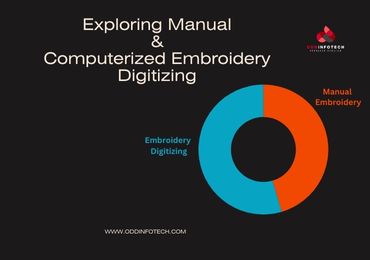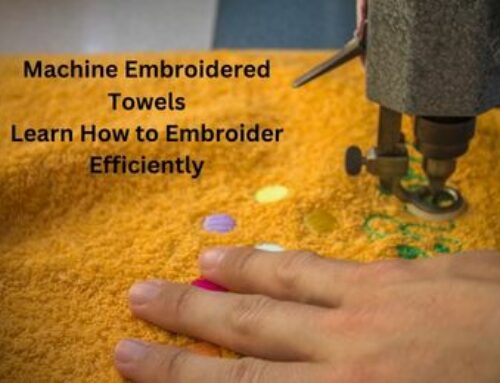Introduction to Embroidery Digitizing
Embroidery digitizing is a pivotal process in the realm of textile decoration, transforming intricate designs into stitch patterns that embroidery machines can replicate onto various fabrics. It merges traditional craftsmanship with modern technology, offering a seamless blend of artistry and efficiency.
What is embroidery digitizing?
Embroidery digitizing involves converting artwork or designs into a digital format compatible with embroidery machines. This digital file contains instructions that dictate the placement, sequence, and types of stitches required to recreate the design accurately.
Historical background of embroidery digitizing
The roots of embroidery trace back centuries, with artisans painstakingly hand-stitching elaborate patterns onto fabrics. However, the advent of technology revolutionized this practice. In the late 20th century, the emergence of computerized embroidery machines facilitated the transition from manual to digital methods. This marked the dawn of embroidery digitizing as we know it today.
Importance of digitizing in modern embroidery
In today’s fast-paced world, efficiency and precision are paramount. Embroidery digitizing streamlines the production process, allowing for rapid replication of intricate designs with consistent quality. From intricate logos on apparel to detailed motifs on home decor items, digitizing has become indispensable across various industries. Its versatility and adaptability make it a cornerstone of contemporary textile decoration practices.
Understanding Manual Embroidery Digitizing
Manual embroidery digitizing involves a meticulous process where skilled artisans translate designs into stitch patterns through hands-on techniques. While it may seem labor-intensive compared to computerized methods, manual digitizing offers a level of artistry and customization that is unparalleled.
Detailed process of manual embroidery digitizing
Design creation by hand
Artisans begin by sketching or tracing the desired design onto paper or fabric. This step requires a keen eye for detail and a steady hand to capture the intricacies of the design accurately.
Transferring design to digitizing software
Once the design is finalized, it is transferred to specialized digitizing software. Unlike computerized methods where designs are input directly into the software, manual digitizing involves manual input of each stitch and its parameters.
Stitch selection and sequence
Artisans meticulously select the types of stitches to use, considering factors such as stitch density, direction, and length. The sequence of stitches is determined based on the design’s complexity and desired outcome.
Manual input of stitch parameters
Each stitch’s parameters, including density, length, and angle, are manually inputted into the software. This step requires precision and attention to detail to ensure the final embroidery aligns with the original design.
Advantages of manual digitizing
Artistic control and customization
Manual digitizing offers artisans unparalleled control over every aspect of the embroidery process. From selecting stitches to fine-tuning parameters, artisans can customize the design to meet their exact specifications.
Ability to fine-tune intricate designs
For complex or highly detailed designs, manual digitizing provides artisans with the flexibility to adjust stitches and parameters as needed. This level of fine-tuning ensures the final embroidery reflects the intricacies of the original design.
Personalized touch for unique projects
Manual digitizing allows artisans to imbue their creations with a unique, handcrafted touch. This personalized approach appeals to customers seeking one-of-a-kind pieces that stand out from mass-produced alternatives.
Cost-effectiveness for small-scale production
While manual digitizing may be labor-intensive, it can be more cost-effective for small-scale production runs. It eliminates the need for expensive equipment and software licenses, making it accessible to smaller businesses and independent artisans.
Manual embroidery digitizing is more than just a process; it’s an art form that celebrates craftsmanship and creativity. While computerized methods offer efficiency and precision, manual digitizing adds a human touch that sets it apart in a digital world.
Exploring Computerized Embroidery Digitizing
Computerized embroidery digitizing revolutionized the textile industry by automating the process of translating designs into stitch patterns. This advanced method utilizes specialized software and machinery to streamline production and ensure consistent, high-quality results.
Overview of computerized embroidery digitizing process
Design input via digital software
The process begins with the creation or acquisition of a digital design file. Designers use specialized software to develop or import designs in various file formats such as vector graphics or bitmap images.
Automated conversion to stitch format
Once the design is inputted into the digitizing software, algorithms analyze the design and automatically convert it into stitch data. This data includes information on stitch types, densities, and sequences required to replicate the design accurately.
Optimization through software algorithms
Digitizing software offers advanced features such as stitch editing, underlay options, and density adjustment. Designers can fine-tune the digitized design to optimize stitch placement and ensure optimal results on different fabrics and materials.
Output of digitized file for machine use
After the design is digitized and optimized, the digitized file is exported in a format compatible with embroidery machines. These files typically include formats such as .DST, .PES, or .EMB, which embroidery machines can read and execute.
Benefits of computerized digitizing
Efficiency and speed in design processing
Computerized digitizing significantly reduces the time and effort required to digitize designs compared to manual methods. Designers can input designs quickly and efficiently, allowing for faster turnaround times on projects.
Consistency and precision in stitch placement
Computerized digitizing ensures consistent stitch placement and quality across multiple reproductions of the same design. This consistency is essential for maintaining brand identity and ensuring customer satisfaction.
Scalability for large-scale production
Computerized digitizing is highly scalable, making it ideal for large-scale production runs. Once a design is digitized, it can be reproduced quickly and accurately, enabling manufacturers to meet high demand without sacrificing quality.
Integration with advanced embroidery machinery
Computerized digitizing seamlessly integrates with advanced embroidery machinery, further enhancing efficiency and precision. Modern embroidery machines offer features such as multiple needle heads, automatic thread cutting, and color-changing capabilities, maximizing productivity and minimizing downtime.
Computerized embroidery digitizing represents the pinnacle of efficiency and precision in the textile industry. While manual methods offer a personal touch, computerized digitizing ensures consistent quality and scalability, making it indispensable for modern production processes.
Comparing Manual and Computerized Embroidery Digitizing
Embroidery digitizing, whether manual or computerized, plays a crucial role in translating designs into stitch patterns for embroidery machines. Understanding the differences between these two methods is essential for businesses and artisans seeking to optimize their production processes.
Accuracy and Precision
Human vs. machine precision in stitch placement
Manual digitizing relies on the skill and expertise of artisans to manually input stitch parameters, leading to variations in stitch placement and consistency. In contrast, computerized digitizing ensures precise stitch placement and consistency across multiple reproductions, thanks to automated algorithms and machine control.
Error rates and quality assurance measures
While both manual and computerized methods strive for accuracy, manual digitizing may be prone to human error, resulting in inconsistencies or imperfections in the final embroidery. Computerized digitizing minimizes errors through automated processes and quality assurance measures, ensuring higher quality and consistency.
Complexity and Design Flexibility
Limitations of manual digitizing for intricate designs
Manual digitizing may struggle to replicate intricate or complex designs accurately, particularly when it comes to fine details or small text. Artisans may face challenges in adjusting stitch parameters to achieve the desired outcome, leading to compromises in design fidelity.
Adaptive capabilities of computerized systems
Computerized digitizing offers unparalleled flexibility and adaptability, allowing designers to digitize even the most intricate designs with ease. Advanced software features such as stitch editing and underlay options enable designers to fine-tune designs for optimal results, regardless of complexity.
Time and Cost Efficiency
Time investment comparison between manual and computerized digitizing
Manual digitizing is time-consuming, requiring artisans to manually input each stitch parameter and fine-tune the design iteratively. In contrast, computerized digitizing significantly reduces the time investment by automating processes such as stitch conversion and optimization, resulting in faster turnaround times on projects.
Cost considerations for equipment, labor, and maintenance
While manual digitizing may require minimal investment in equipment, it can be labor-intensive and costly in terms of skilled labor. Computerized digitizing, while requiring initial investment in software and machinery, offers long-term cost savings through increased efficiency, reduced labor costs, and lower error rates.
Skill Requirements and Learning Curve
Skill sets needed for manual vs. computerized digitizing
Manual digitizing relies heavily on the expertise of skilled artisans with a deep understanding of embroidery techniques and design principles. In contrast, computerized digitizing requires proficiency in specialized software and familiarity with digital design concepts, making it accessible to a broader range of individuals with technical aptitude.
Training and education resources available for both methods
Numerous training programs, workshops, and online tutorials are available for both manual and computerized digitizing, catering to beginners and advanced users alike. While manual digitizing may require apprenticeships or hands-on training, computerized digitizing offers self-paced learning opportunities through online courses and certification programs.
Understanding the differences between manual and computerized embroidery digitizing is essential for businesses and artisans seeking to optimize their production processes and deliver high-quality embroidery products efficiently. While each method has its advantages and limitations, choosing the right approach depends on factors such as project requirements, budget constraints, and skill level.
Industries and Applications
Embroidery digitizing finds extensive applications across various industries, enhancing branding, customization, and aesthetic appeal. From traditional sectors like fashion and textiles to emerging markets such as automotive and promotional products, embroidery digitizing plays a pivotal role in elevating product offerings and meeting consumer demands.
Traditional Industries
Fashion and apparel
Embroidery digitizing adds intricate details and embellishments to garments, elevating their visual appeal and perceived value. From haute couture to casual wear, embroidery enhances brand identity and creates a unique selling proposition for fashion brands.
Textile manufacturing
In the textile industry, embroidery digitizing is utilized to embellish fabrics and textiles, adding texture, dimension, and visual interest to products such as upholstery, drapery, and linens. Embroidered textiles command premium prices and cater to discerning customers seeking luxury and sophistication.
Home decor and furnishings
Embroidery digitizing transforms ordinary home decor items into personalized works of art, from embroidered pillows and throws to curtains and table linens. Customized embroidery allows homeowners to express their individual style and elevate the ambiance of their living spaces.
Emerging Markets
Automotive and aviation
In the automotive and aviation industries, embroidery digitizing is used to customize interiors, upholstery, and accessories, adding a touch of luxury and exclusivity to vehicles and aircraft. Customized embroidery enhances brand differentiation and creates a memorable experience for passengers and drivers alike.
Promotional products
Embroidery digitizing is widely employed in the production of promotional products such as branded apparel, accessories, and corporate gifts. Customized embroidery enhances brand visibility and serves as a tangible marketing tool for businesses seeking to create lasting impressions on customers and prospects.
Sports and leisurewear
In the sports and leisurewear market, embroidery digitizing is utilized to create team uniforms, athletic apparel, and branded merchandise. Customized embroidery allows sports teams, clubs, and organizations to showcase their logos, mascots, and insignia with pride, fostering a sense of unity and identity among participants and fans.
Embroidery digitizing transcends industry boundaries, offering endless possibilities for customization, personalization, and creative expression. As technology continues to evolve and new applications emerge, embroidery digitizing will remain a versatile and indispensable tool for businesses seeking to differentiate themselves in competitive markets.
Future Trends in Embroidery Digitizing
The landscape of embroidery digitizing is constantly evolving, driven by advancements in technology, changing consumer preferences, and sustainability considerations. As we look to the future, several key trends are poised to shape the trajectory of the industry, offering new opportunities for innovation and growth.
Technological Advancements
AI and machine learning in digitizing algorithms
The integration of artificial intelligence (AI) and machine learning algorithms into embroidery digitizing software holds immense potential for automating and optimizing the digitization process. AI-driven algorithms can analyze design elements, predict stitching patterns, and recommend optimal settings, streamlining production and enhancing accuracy.
Integration with IoT and smart devices
Embroidery machinery equipped with Internet of Things (IoT) capabilities can communicate seamlessly with digital devices, enabling remote monitoring, predictive maintenance, and real-time performance tracking. Smart embroidery machines offer enhanced connectivity and data analytics capabilities, empowering businesses to optimize production processes and improve efficiency.
3D embroidery and multi-material stitching
The development of advanced embroidery techniques, such as 3D embroidery and multi-material stitching, opens up new creative possibilities for designers and manufacturers. By incorporating three-dimensional elements and diverse materials into embroidery designs, businesses can create visually striking and tactilely engaging products that captivate consumers.
Sustainability and Eco-Friendly Practices
Digital optimization for material efficiency
Embroidery digitizing software can optimize stitch placement and density to minimize material waste and maximize resource utilization. By reducing thread consumption and optimizing production efficiency, businesses can lower their environmental footprint and contribute to sustainable practices.
Recycling and upcycling initiatives
Embroidery digitizing presents opportunities for recycling and upcycling textile waste into new products and designs. By repurposing discarded materials and incorporating them into embroidery projects, businesses can reduce waste generation and promote circular economy principles.
Reduced environmental footprint in production processes
As environmental awareness grows, embroidery digitizing manufacturers are increasingly adopting eco-friendly production practices and materials. From water-based inks and organic threads to energy-efficient machinery, sustainable solutions are becoming increasingly prevalent in the embroidery digitizing industry, aligning with consumer preferences for environmentally conscious products.
The future of embroidery digitizing is characterized by technological innovation, sustainability, and creative expression. By embracing emerging trends and leveraging cutting-edge technologies, businesses can stay ahead of the curve and unlock new opportunities for growth and differentiation in the dynamic textile industry landscape.
Conclusion
Embroidery digitizing stands at the intersection of artistry and technology, offering a myriad of possibilities for creative expression and production efficiency. As we conclude our exploration of the key differences between manual and computerized embroidery digitizing, it’s evident that each method brings its own set of advantages and considerations to the table.
Recap of key differences between manual and computerized digitizing
Manual embroidery digitizing offers artisans unparalleled control and customization, allowing for the creation of unique, handcrafted designs with a personalized touch. However, it can be labor-intensive and time-consuming, limiting its scalability for large-scale production.
On the other hand, computerized embroidery digitizing streamlines the digitization process, offering efficiency, precision, and scalability for businesses seeking to meet high-demand production requirements. While it may lack the human touch of manual digitizing, it compensates with consistency, speed, and automation.
Considerations for choosing the appropriate method
When deciding between manual and computerized embroidery digitizing, businesses and artisans must consider factors such as project requirements, budget constraints, and skill level. Manual digitizing may be ideal for niche projects requiring artistic control and customization, while computerized digitizing offers efficiency and scalability for mass production.
Future outlook and potential advancements
Looking ahead, the future of embroidery digitizing is characterized by technological advancements, sustainability initiatives, and creative innovation. From AI-driven digitizing algorithms to eco-friendly production practices, the industry is poised for continuous evolution and growth.
In conclusion, embroidery digitizing is a dynamic and transformative process that continues to shape the textile industry landscape. By understanding the nuances between manual and computerized methods and embracing emerging trends, businesses and artisans can unlock new opportunities for creativity, efficiency, and sustainability in the digital age of embroidery.
FAQs (Frequently Asked Questions)
1. Is manual digitizing still relevant in today’s digital age?
- Yes, manual digitizing offers unique advantages such as artistic control and customization, making it relevant for niche and personalized projects.
2. Are there any drawbacks to computerized embroidery digitizing?
- While computerized digitizing offers efficiency and precision, initial investment costs and reliance on technology can be perceived as drawbacks for some businesses.
3. How can I learn embroidery digitizing?
- Numerous online resources, tutorials, and workshops are available for both manual and computerized digitizing, catering to beginners and advanced users alike.
4. Can computerized digitizing replicate the intricate details of manual designs?
- Yes, modern software and advanced machinery enable computerized digitizing to replicate intricate details with high precision, often surpassing manual capabilities.
5. Which industries benefit the most from embroidery digitizing?
- Industries such as fashion, textiles, automotive, and promotional products extensively utilize embroidery digitizing to enhance branding, customization, and product aesthetics.







Leave A Comment